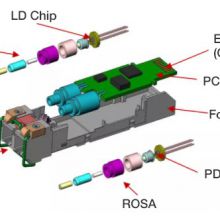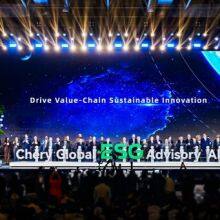
1. Introduction of optical moduleAs an important part of fiber optic communication, optical module is an optoelectronic device that realizes the function of photoelectric conversion and electro-optical conversion. To be precise, optical module is the general name of several types of modules, including optical transmitting module transmitter, optical receiving module receiver, optical transceiver module transmitter and optical forwarding module transmitter. Generally, the optical module we call generally refers to the integrated optical transceiver module, namely, optical transceiver. ① Working principle of optical transceiver Optical transceiver works in the physical layer of OSI model and is one of the core devices in optical fiber communication system. It is mainly composed of optoelectronic devices (optical transmitter, optical receiver), functional circuit and optical (Electrical) interface. Components of an optical transceiver Basic principle: the transmitting interface inputs an electrical signal with a certain code rate. After being processed by the internal driving chip, the driving semiconductor laser (LD) or light emitting diode (LED) emits a modulated optical signal with a corresponding rate. After being transmitted through the optical fiber, the receiving interface converts the optical signal from the optical detection diode into an electrical signal, After passing through the preamplifier, the electrical signal of the corresponding code rate is output. ② Key parameters of optical transceiver The key technical indicators of the optical transceiver mainly include: transmitting optical power, receiving optical power, overload optical power, maximum receiving sensitivity and extinction ratio. A. Transmitting optical power: refers to the optical power output by the light source at the transmitting end of the optical module under normal working conditions, which can be understood as the intensity of light, and the unit is w or MW or DBM. Where w or MW is the linear unit and DBM is the logarithmic unit. In communication, we usually use DBM to represent optical power, and the optical power of 0dbm corresponds to 1MW.B. Receiving optical power: refers to the average optical power range that can be received by the receiving end component under the condition of a certain bit error rate (BER = 10-12). The upper limit value is the overload optical power, and the lower limit value is the maximum value of reception sensitivity.C. Overload optical power: also known as saturated optical power, it refers to the maximum input average optical power that can be received by the receiver component when a certain bit error rate (BER = 10-12) is maintained at a certain transmission rate (unit: DBM). It should be noted that the photocurrent saturation of the photodetector will occur under strong light irradiation. Therefore, strong light irradiation should be avoided as far as possible to prevent exceeding the saturated light power.D. Receiving sensitivity: refers to the minimum average input optical power that can be received by the receiving end component when a certain bit error rate (BER = 10-12) is maintained at a certain transmission rate (unit: DBM). Generally, the higher the rate, the worse the reception sensitivity, that is, the greater the minimum received optical power, and the higher the requirements for the receiving devices of the optical transceiver.E. Extinction ratio (EXT): it is one of the important parameters used to measure the quality of optical modules. It refers to the ratio of the optical power P1 (when the laser emits all "1" codes) to P0 (when the laser emits all "0" codes) under the condition of full modulation, and the unit is dB. It is not that the greater the extinction ratio, the better the quality of the optical module, but that the optical module with an extinction ratio can meet the IEEE 802.3 standard is the better. ③ Example of optical transceiver information on the switch: Cisco switch interface optical transceiver information: Huawei switch interface optical transceiver information:2. Classification and packaging(form-factor) of optical transceivers ① Transmission rate: The current common types of optical modules are as follows:400GE optical module200GE optical module100GE optical module40GE optical module25GE Optical Module10GE Optical ModuleGE Optical ModuleFE Optical Module ② Form-factors: The higher the transmission rate, the more complex the structure, resulting in form-factors. For example, SFP/eSFP, SFP+, SFP28, QSFP+, CXP, CFP, QSFP28, etc. l SFP (Small Form-factor Pluggable) optical module: small pluggable SFP module supports LC fiber connector.l SFP + (Small Form-factor Pluggable plus) optical module: refers to the SFP module with increased rate. Because of the increased rate, it is sensitive to EMI and smaller than the SFP module.l XFP (10GB Small Form-factor Pluggable) optical module: "X" is the abbreviation of Roman numeral 10. All XFP modules are 10GE optical modules. The XFP optical module supports LC optical fiber connectors. Compared with SFP + optical module, XFP optical module is wider and longer in size.l SFP28 (Small Form-factor Pluggable 28) optical module: the interface package size is the same as that of SFP +, and supports 25G SFP28 optical module and 10G SFP + optical module.l QSFP+ (Quad Small Form-factor Pluggable) optical module: four channel small hot pluggable optical module. QSFP + optical module supports MPO optical fiber connector, which is larger than SFP + optical module. Fiber Mall 40G QSFP+ Optical Transceivers l CXP (120 GB/s Extended Capability Form-factor Pluggable) optical module: it is a hot-pluggable high-density parallel optical module standard. It provides 12 channels in the transmit and receive (TX / Rx) directions. It is only applicable to short-range multimode links.l CFP (CENTUM Form-factor pluggable) optical module: the size is defined as 144.75mm × 82mm × 13.6mm, which is a new optical module standard with high speed, hot-pluggable and supporting two applications of data communication and telecommunication transmission.l QSFP28 (Quad Small Form-factor Pluggable 28) optical module: the interface package size is the same as QSFP+, and supports 100G QSFP28 optical module and 40G QSFP+ optical module. ③ Single-mode or muti-mode? The optical fiber is divided into single-mode optical fiber and multi-mode optical fiber. The single-mode optical module is used together with the single-mode optical fiber. The single-mode optical fiber has wide transmission frequency bandwidth and large transmission capacity, which is suitable for long-distance transmission; The multi-mode optical module is used together with multi-mode optical fiber, and multi-mode optical fiber has mode dispersion defect, and its transmission performance is worse than that of single-mode optical fiber, but the cost is low. Therefore, it is suitable for small capacity and short-distance transmission. ④ Wavelength The central wavelength refers to the waveband used for optical signal transmission. At present, there are three kinds of common central wavelengths: 850nm, 1310nm and 1550nm.850nm: mostly used for short distance transmission (≤ 2km)1310nm and 1550nm: mostly used for medium and long distance transmission (>2km) ⑤ Transmission distance According to the different transmission distance of optical module, it can be divided into:Short distance optical module: ≤ 2kmMedium distance optical module, 10 ~ 20kmLong distance optical module: ≥30km.The transmission distance of optical modules is limited mainly because of the loss and dispersion of optical signals during fiber transmission. ⑥ Photoelectric module The photoelectric module is usually called electric port module or RJ45 SFP module. Unlike the optical module, the electric port module does not carry out photoelectric conversion. Through the switching of the electric module, the two optical interfaces can be connected with a network cable.RJ45 Copper SFP Module 3. Development and evolution of optical transceiversIn the current physical architecture network of mainstream data centers, Spine-Leaf (Clos network architecture) architecture is commonly followed. Usually 10GE interface is used as the access side server docking, and 40GE interface is commonly used for the uplink on the Leaf side. In large data centers, it has been common to use 25G as the mainstream access and 100G uplink. In scenarios requiring high computation and high bandwidth, GPU servers have been using 100GE and even 200GE access. Data center switch interconnects are evolving to large-scale 400GE interconnects.The development of Ethernet has undergone rapid changes from 1Mbit/s, 10Mbit/s, 100Mbit/s (FE), 1Gbit/s (GE), 10Gbit/s (10GE) to 40Gbit/s (40GE), 100Gbit\s (100GE), and with the rapid development of big data, smart cities, mobile Internet, cloud computing, network traffic has shown exponential growth. The thirst for continuous growth of bandwidth will require higher bandwidth rates, and optical modules will develop rapidly.
Fiber Optic Transceivers Optical Module Fiber Optic 2991 81 07/29/21RECENT POSTS

WUHU, China, Oct. 25, 2025 /PRNewswire/ -- As carbon neutrality becomes a global consensus and intelligent transformation reshapes industries, the automotive value chain is undergoing a profound shift—from hardware-driven competition to ecosystem co-creation. At this historic juncture, the 2025 Chery International User Summit built an open global platform, becoming a focal point for the entire industry. With its core theme "Co-Create • Co-Define," the summit served not only as a showcase of Chery's global achievements but also as a declaration of future mobility. Positioned as a pioneer in smart and green mobility, Chery is reshaping industry boundaries through user co-creation and shared value—offering systematic, sustainable solutions that unite people, vehicles, and nature. the 2025 Chery International User Summit built an open global platform Shared Green Vision: Turning Commitment into Global Action In response to global climate and resource challenges, Chery Group integrates ESG into its core strategy and decision-making, setting an example of responsible growth. Chery has evolved from product export to cultural and lifestyle co-creation, building a sustainable global community. During the summit, the upgraded Chery Global ESG Advisory Alliance was officially launched under the witness of international dignitaries, marking a new phase of global ESG collaboration for Chery. Led by Mr. Ban Ki-moon, the 8th Secretary-General of the United Nations and Chery Global ESG Honorary Advisor, the Alliance brings together leading figures from international sustainability organizations and industrial chain partners. Their participation injects cutting-edge global insight and strong professional support into Chery's ESG strategy—demonstrating the company's determination to lead the industry in ESG standard-setting and to advance large-scale sustainable mobility worldwide." During the summit, Mr. Ban Ki-moon remarked: "In today's changing world, we need vital leadership from all sectors to help transcend the pressing challenges we are facing. Against this backdrop, I believe that Chery's commercially successful ESG practices could offer a viable new path for the larger automotive industry to forge win-win victories for both business and societal value." Mr. Ban Ki-moon particularly emphasized: "Chery's concrete actions – such as establishing 'Green Factories', developing advanced new energy technologies, building a responsible supply chain, and supporting education – show how broad goals translate into tangible steps, demonstrating timely corporate citizenship. I firmly believe that this shared commitment, and dynamic convergence exemplifies the guiding spirt: 'actions speak louder than words'." Led by Mr. Ban Ki-moon, the 8th Secretary-General of the United Nations and Chery Global ESG Honorary Advisor At the summit, Chery Group and UNICEF jointly announced a renewed three-year strategic partnership, with an additional USD 6 million commitment to create inclusive, healthy, and safe learning environments for children worldwide. Meanwhile, Chery will further strengthen its partnership with the International Union for Conservation of Nature (IUCN) through the global "Cherish the Nature" initiative, advancing Nature-based Solutions (NbS) as a cornerstone of its sustainable growth strategy- demonstrating how environmental protection can drive lasting economic and social value. As the first Chinese automaker (with its first vehicle model) to receive the Sino-Europe Automotive Carbon Footprint Mutual Recognition Certificate, Chery's ESG system—built on three pillars: low-carbon transformation and nature-positive action, value chain co-creation, and integrity-driven growth—is turning sustainability from corporate vision into measurable, industry-wide practices. Technology as the Foundation: Innovation with a Human Touch A solid technological foundation has always been the core strength of Chery Group's sustainable growth. Amid industry transformation, Chery remains committed to its "Technology-Oriented" strategy—pioneering a path of innovation that is both eco-friendly and value-driven, empowering the global automotive sector toward a sustainable future. During the summit, more than ten breakthrough technologies were unveiled, including the next-generation hybrid engine, humanoid robots, intelligent digital chassis, amphibious mobility systems, autonomous driving large models, and flying mobility platforms. The AiMOGA Robotics made its independent debut, astonishing audiences by autonomously performing tasks such as pouring juice and assisting as an award presenter—demonstrating its full potential as a reliable, human-centered intelligent companion. These technological breakthroughs stem not only from years of engineering expertise but also from the synergistic power of Chery's global R&D network. This open and forward-looking global innovation system continues to fuel "Technology Chery," while serving as a driving force for the global automotive industry's green and intelligent transformation. Co-Creation and Shared Value: When Users Become Product Designers If technology is the backbone of Chery's progress, then user co-creation is its soul. At the summit, more than 3,000 representatives from Chery's 17.72 million global users took part as true "product managers," deeply engaging in defining the brand's meaning and future direction. Throughout the venue, users from diverse countries exchanged stories about their journeys with Chery. They tested vehicles on professional tracks, shared feedback in design workshops, witnessed automation at Chery's Smart Factory in Changshu, and even co-created at the world's first LEPAS Global Boutique Store—all while echoing the OMODA&JAECOO spirit: "My car, my definition!" "We are not here to listen to stories—we are here to write them," said a dealer from Brazil at the User Festival. From design customization to user rights, from smart cabin UX to service processes—user feedback is now systematically gathered, refined, and applied to Chery's product development and brand evolution. No matter who they are or where they come from, every user shares the same goal—to build better vehicles. Co-creation has thus become the new starting point of Chery's innovation journey. Chery is transforming its sustainability commitments into measurable and tangible practices—together with global users, at a pivotal moment for the industry From Explorer to Leader: The Time for Evolution Is Now The 2025 Chery International User Summit was not only a celebration of technology and ecosystem innovation but also a profound practice of co-creation, co-definition, and co-prosperity with users. As Mr. Yin Tongyue, Chairman of Chery Automobile Co., Ltd. (9973.HK), noted, under the guidance of the "In somewhere, For somewhere, Be somewhere" globalization strategy, Chery Group hope to develop low-carbon and zero-carbon technologies by collaborating with more global partners. It seeks to fulfill its responsibility as a global corporate citizen through practical actions, forming a new global paradigm of shared technology, co-created value, and mutually beneficial growth, ultimately to do good to human beings. From an automaker to a creator of intelligent mobility ecosystems, Chery is transforming its sustainability commitments into measurable and tangible practices—together with global users, at a pivotal moment for the industry.

DANBA, China, Oct. 25, 2025 /PRNewswire/ -- Jikayi Village, located in Danba County, Garzê Prefecture, Sichuan Province, China, was officially designated as a "Best Tourism Village" by United Nations Tourism on October 17, 2025. Through its embodiment of Eastern philosophical wisdom—particularly the principle of harmonious coexistence between humans and nature—alongside robust ecological conservation practices, sustainable development strategies, and the dynamic preservation of a millennium-old cultural heritage, the village has achieved international recognition, offering a compelling representation of the profound essence of Eastern aesthetics. Jikayi Village, Danba County, Garzê Prefecture, now known as the "World's Best Tourist Village" on the Qinghai-Xizang Plateau Ecological empowerment, "Turning green into gold" Jikayi Village is situated in the central part of the Moerduo Mountain Provincial Nature Reserve and lies adjacent to the World Natural Heritage Site "Habitat of the Giant Panda." The village is renowned for its breathtaking natural landscapes, including spectacular sea-of-clouds phenomena and sunrise views, which serve as some of the main attractions drawing visitors from around the globe. The local government regards ecological preservation as the cornerstone of sustainable development, and is committed to establishing Jikayi Village as an "international ecological and cultural tourism destination." Leveraging its unique ecological advantages as a "natural oxygen bar," the village has systematically developed educational tourism programs centering around a "Forest+" theme, attracting over 330,000 visitors from more than 20 countries from January to September 2025. During this period, comprehensive tourism revenue reached 364 million RMB. In 2024, the per capita disposable income of local residents amounted to 34,000 RMB, providing empirical support for the principle that "green mountains and clear waters are as valuable as mountains of gold and silver." Comprehensive business integration addresses the seasonal challenges Under the guidance of Garzê Prefecture's "all-domains and all-industries" development strategy, Jikayi Village has innovatively expanded its "culture and tourism plus diverse industries" network, effectively overcoming the seasonal constraints inherent to rural tourism. By establishing a year-round thematic activity framework—featuring spring flower viewing, summer cooling retreats, autumn beauty pageants, and winter sunbathing—the village has successfully extended its peak tourism period from the traditionally short spring and summer months to a full-year cycle. The achievements are remarkable. The proportion of winter tourists has risen from less than 10% three years ago to 22% today. The occupancy rate of Bed & Breakfasts in winter has consistently stayed above 30%. Currently, over 90% of the 92 households in the village are engaged in tourism-related industries. Villagers have transformed into Bed & Breakfast owners, live-streaming influencers, and photographers right on their own doorsteps, steadily enjoying the dividends brought by the development of tourism. Cultural heritage demonstrates the renewed appeal of "Oriental beauty" Jikayi Village is one of the important cradles of the Jiarong Tibetan and Dongnü cultures (Dongnü culture centers on women and is characterized by the veneration of the feminine), and as such actively preserves the Tibetan tower-building craftsmanship and the Tibetan folk singing traditions of western Sichuan, among other national and provincial-level intangible cultural heritages. Jikayi village itself is a living museum of Jiarong architecture. Through the "intangible cultural heritage + tourism and culture" model, local intangible cultural heritage projects such as black pottery making and Jiarong embroidery have been ingeniously integrated into Bed & Breakfast and tourist experiences. The innovative immersive project "A Day in the Life of the Dongnü Queen" combines role-playing games with Jiarong culture and historical legends, allowing tourists to personally experience the charm of China's diverse cultures. Local specialty products such as pepper coffee, which carry the original ecological quality and cultural elements of the plateau, have successfully entered the domestic and even international markets.

As Shanghai Electric's fourth photovoltaic project in Romania, this initiative marks a major step forward for the country's clean energy sector. SHANGHAI, Oct. 24, 2025 /PRNewswire/ -- Shanghai Electric (SEHK: 2727, SSE: 601727) celebrated a major milestone on October 1 with the signing of the second phase of the 342 MW photovoltaic (PV) general contracting project (the "Project") in Parau, Romania, with Econergy Renewable Energy Ltd. ("Econergy"). Once completed, the project is expected to supply clean electricity to both residential and commercial users, underscoring Shanghai Electric's steadfast commitment to advancing green energy development across Central and Eastern Europe. "Shanghai Electric will continue to harness its technological strengths in wind power, photovoltaics, and energy storage to drive the region's green transition," said Mr. Wu Lei, Secretary of the Party Committee and Chairman of Shanghai Electric Group. "Building on our successfully completed projects in Romania, we aim to further strengthen our presence across Central and Eastern Europe and deliver tailored solutions that accelerate Romania's energy transformation." The Project also represents a key component of Econergy's strategic expansion across Romania and the wider Central and Eastern European region. According to Andrea Loi, Vice President of Operations at Econergy, "Our decision to partner with Shanghai Electric reflects our full confidence in its technical expertise, project execution capabilities, and extensive international experience. We look forward to close cooperation between our teams to ensure the smooth progress and successful commissioning of this landmark project." The Parau Phase 2 project is Shanghai Electric's fourth photovoltaic initiative in Romania, building upon the company's established track record in the country's renewable energy sector. This follows the successful commissioning of the Parau Phase I 91.4 MW PV project, which was also executed by Shanghai Electric under an EPC contract. The Phase I project received its Provisional Acceptance Certificate from the client in November 2024 and now supplies green electricity to approximately 70,000 households, reducing carbon dioxide emissions by about 6,800 tons annually. Shanghai Electric's Romanian portfolio further includes the Schultu 56 MW PV Project, which achieved provisional acceptance in June of this year and has now entered its two-year warranty and operation period, while the Ovidi's 60 MW PV EPC project, contracted in January, is currently under construction. As of October 2025, Shanghai Electric's projects in Romania have a combined capacity of approximately 550 MW, providing sustained momentum for the nation's long-term clean energy development. On the same day as the signing of the Parau Phase II 342 MW PV project, Mr. Wu Lei held separate meetings with Chinese Ambassador to Romania Chen Feng and Istvan-Lorant Antal, Chairman of the Romanian Energy Committee. "Romania is actively advancing its energy structure transformation, primarily in the areas of photovoltaics, energy storage, gas turbines, and power transmission and distribution. We're looking forward to deepening cooperation with outstanding enterprises like Shanghai Electric to jointly develop renewable energy projects," said Istvan-Lorant Antal. Mr. Wu Lei also conducted high-level talks with executives from Austria's OMV Group to explore new cooperation opportunities in the region's energy sector, further strengthening Shanghai Electric's pivotal role in Romania's renewable energy transition. For more information, please visit https://www.shanghai-electric.com/group_en/.

PHU QUOC, Vietnam, Oct. 24, 2025 /PRNewswire/ -- JW Marriott Phu Quoc Emerald Bay Resort & Spa has been named among the Top 5 Resorts in Asia in the Condé Nast Traveler Readers' Choice Awards 2025, reaffirming its position as one of the region's most extraordinary luxury escapes. This recognition arrives as the resort unveils "A Symphony Beneath the Stars", a festive celebration that transforms the whimsical Lamarck University setting into a stage of wonder, joy, and togetherness. Named as Asia’s Top 5 Resort, JW Marriott Phu Quoc Emerald Bay Resort & Spa is a masterpiece of design and hospitality One of the industry's most prestigious honors, the Condé Nast Traveler Readers' Choice Awards shine a spotlight on the planet's finest hotels, resorts, cruises, airlines, spas, cities, islands, and more. For JW Marriott Phu Quoc Emerald Bay Resort & Spa to be voted as the #5 "World Resort" – Asia region is a truly outstanding achievement and a reflection of how the resort has transformed five-star hospitality in Vietnam with its deeply immersive design concept, spectacular accommodation, sensational cuisine, and authentic local activities. Steeped in the legend of a forgotten astrological project once hidden in the university's archives, this year's festivities invite guests to pause, look skyward, and rediscover the beauty of connection beneath the constellations. The season unfolds as a living symphony, each occasion a luminous movement in a larger score. This year's celebrations take shape like a symphony, each evening offering its own movement of joy. The festivities open with the Tree Lighting Ceremony on December 24, setting the tone for days of warmth and wonder. That same night, guests are invited to indulge in a grand Christmas Eve Buffet at Tempus Fugit, the resort's all-day beachfront restaurant known for its vibrant Vietnamese specialties and global classics, while Pink Pearl by Olivier E., a glamorous French mansion inspired by the Belle Époque, presents a decadent black-truffle feast that redefines fine dining on the island. On Christmas Day, families can gather by the shore for a Family Beach BBQ at Red Rum, the laid-back grill famed for fresh seafood and flame-kissed flavors, with carols drifting across the campus to complete the magical atmosphere. From December 26 to 30, the season takes on a more playful rhythm. Guests can wander through a lantern-lit Festive Night Market at Place de Lamarck, discover local flavors alongside holiday treats, or savor indulgent menus across the resort. Red Rum's seafood platters and barbecue nights celebrate the bounty of the ocean, while Tempus Fugit introduces truffle-inspired dishes for gourmands. Families can also gather at French & Co, the resort's patisserie and tearoom, for daily festive afternoon teas of delicate pastries and seasonal sweets. Between feasts, children and parents alike are invited to marvel at the Family Magic Show, staged every Monday, Wednesday, and Friday to spark wonder for all ages. The celebrations crescendo on December 31, when Tempus Fugit hosts a New Year's Eve Gala Buffet with a dazzling array of international cuisines, while Skewer Street brings a shoreline feast of smoky grilled specialties. At the Department of Chemistry Bar, famed for its creative cocktails and theatrical mixology, guests will count down to midnight before fireworks lighting up Emerald Bay. To carry the joy into 2026, New Year's Day brunches, truffle menus at Tempus Fugit, and new seasonal offerings at Pink Pearl by Olivier E. set the stage for fresh beginnings, while French & Co continues its signature afternoon teas with a festive twist. For more information about JW Marriott Phu Quoc Emerald Bay Resort & Spa, please visit www.marriott.com/en-us/hotels/pqcjw-jw-marriott-phu-quoc-emerald-bay-resort-and-spa/overview.


